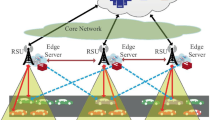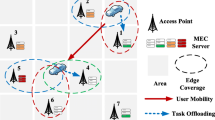Abstract
Vehicular Edge Computing is the specific application of Mobile Edge Computing in vehicular scenarios. In this work, to efficiently provide on-demand computational resource access for Mission Vehicles, Road Side Units (RSUs) and Cooperative Vehicles are both mounted with edge servers. To further improve the performance of this system, we firstly study the dynamic and cooperative task caching between RSUs. Under the control of the central controller, our caching scheme fully utilizes edge servers’ storage resources. Then, we resort to Deep Deterministic Policy Gradient (DDPG) algorithm to adapt to the time-varying wireless environment. Moreover, we propose the DDPG-OCWB algorithm to improve the convergence performance of DDPG. Finally, numerical results verify the improved performance of our proposed algorithm. Based on a detailed comparison with existing research schemes, it is evident that our scheme dramatically reduces system delay while utilizing edge servers’ energy efficiently.











Similar content being viewed by others
Data availability
The datasets generated during and/or analysed during the current study are available from the corresponding author on reasonable request
References
Qiao, G., Leng, S., Maharjan, S., Zhang, Y., Ansari, N.: Deep reinforcement learning for cooperative content caching in vehicular edge computing and networks. IEEE Internet Things J. 7(1), 247–257 (2020)
Feng, J., Liu, Z., Wu, C., Ji, Y.: Mobile edge computing for the internet of vehicles: offloading framework and job scheduling. IEEE Veh. Technol. Mag. 14(1), 28–36 (2019)
Zhao, J., Ni, S., Yang, L., Zhang, Z., Gong, Y., You, X.: Multiband cooperation for 5G HetNets: a promising network paradigm. IEEE Veh. Technol. Mag. 14(4), 85–93 (2019). https://doi.org/10.1109/MVT.2019.2935793
Abbas, N., Zhang, Y., Taherkordi, A., Skeie, T.: Mobile edge computing: a survey. IEEE Internet Things J. 5(1), 450–465 (2018). https://doi.org/10.1109/JIOT.2017.2750180
Jian, C., Bao, L., Zhang, M.: A high-efficiency learning model for virtual machine placement in mobile edge computing. Cluster Comput 25, 3051–3066 (2022). https://doi.org/10.1007/s10586-022-03550-1
Shinde, S.S., Bozorgchenani, A., Tarchi, D., Ni, Q.: On the design of federated learning in latency and energy constrained computation offloading operations in vehicular edge computing systems. IEEE Trans. Veh. Technol. 71(2), 2041–2057 (2022). https://doi.org/10.1109/TVT.2021.3135332
Zhang, K., et al.: Optimal charging schemes for electric vehicles in smart grid: a contract theoretic approach. IEEE Trans. Intell. Transp. Syst. 19(9), 3046–3058 (2018). https://doi.org/10.1109/TITS.2018.2841965
Liu, P., Xu, G., Yang, K., Wang, K., Meng, X.: Jointly optimized energy-minimal resource allocation in cache-enhanced mobile edge computing systems. IEEE Access 7, 3336–3347 (2019)
Ning, Z., Zhang, K., Wang, X., Guo, L., Hu, X., Huang, J., Hu, B., Kwok, R.Y.K.: Intelligent edge computing in internet of vehicles: a joint computation offloading and caching solution. IEEE Trans. Intelligent Transp. Syst. 22(4), 2212–2225 (2021)
Zhang, K., Leng, S., Peng, X., Pan, L., Maharjan, S., Zhang, Y.: Artificial intelligence inspired transmission scheduling in cognitive vehicular communications and networks. IEEE Internet Things J. 6(2), 1987–1997 (2019)
Bishoyi, P.K., Misra, S.: Enabling green mobile-edge computing for 5g-based healthcare applications. IEEE Trans. Green Commun. Netw. 5(3), 1623–1631 (2021)
Sarkar, S., Chatterjee, S., Misra, S.: Assessment of the suitability of fog computing in the context of internet of things. IEEE Trans. Cloud Comput. 6(1), 46–59 (2018)
Xiao, Y., Krunz, M.: Distributed optimization for energy-efficient fog computing in the tactile internet. IEEE J. Select. Areas Commun. 36(11), 2390–2400 (2018)
Tang, D., Zhang, X., Tao, X.: Delay-optimal temporal-spatial computation offloading schemes for vehicular edge computing systems. In: IEEE Wireless Communications and Networking Conference (WCNC), pp. 1–6 (2019)
Chen, J., Yang, H., Wei, N., et al.: User behavior analysis based on edge evolutionary game model in social network. Cluster Comput (2022). https://doi.org/10.1007/s10586-022-03612-4
Li, S., Lin, S., Cai, L., Li, W., Zhu, G.: Joint resource allocation and computation offloading with time-varying fading channel in vehicular edge computing. IEEE Trans. Veh. Technol. 69(3), 3384–3398 (2020)
Gupta, A., Cherukara, J.J., Gangadharan, D., Kim, B., Sokolsky, O., Lee, I.: E-pods: a fast heuristic for data/service delivery in vehicular edge computing. In: 2021 IEEE 93rd Vehicular Technology Conference (VTC2021-Spring), pp. 1–6 (2021)
Mao, J., Li, X., Luo, X., Lin, Q.: SybilHunter: hybrid graph-based sybil detection by aggregating user behaviors. Neurocomputing 500, 295–306 (2022)
Tang, M., Wong, V.W.: Deep reinforcement learning for task offloading in mobile edge computing systems. IEEE Trans. Mob. Comput. 1 (2020)
Xu, X., Shen, B., Ding, S., Srivastava, G., Bilal, M., Khosravi, M.R., Menon, V.G., Jan, M.A., Maoli, W.: Service offloading with deep q-network for digital twinning empowered internet of vehicles in edge computing. IEEE Trans. Ind. Inform. 1 (2020)
Mao, J., Liu, Z., Lin, Q., Liang, Z.: Semantic-fuzzing-based empirical analysis of voice assistant systems of Asian symbol languages. IEEE Internet Things J. 9(12), 9151–9166 (2022)
Qiu, X., Zhang, W., Chen, W., Zheng, Z.: Distributed and collective deep reinforcement learning for computation offloading: a practical perspective. IEEE Trans. Parallel Distrib. Syst. 32(5), 1085–1101 (2021)
Xu, J., Chen, L., Zhou, P.: Joint service caching and task offloading for mobile edge computing in dense networks. In: IEEE INFOCOM 2018—IEEE Conference on Computer Communications, pp. 207–215 (2018)
Sengupta, A., Amuru, S., Tandon, R., Buehrer, R.M., Clancy, T.C.: Learning distributed caching strategies in small cell networks. In: 2014 11th International Symposium on Wireless Communications Systems (ISWCS), pp. 917–921 (2014)
Nath, S., Wu, J.: Deep reinforcement learning for dynamic computation offloading and resource allocation in cache-assisted mobile edge computing systems. Intell. Converg. Netw. 1(2), 181–198 (2020)
Zhang, J., Letaief, K.B.: Mobile edge intelligence and computing for the internet of vehicles. Proc. IEEE 108(2), 246–261 (2020)
Chen, J., Mao, G., Li, C., Zhang, D.: A topological approach to secure message dissemination in vehicular networks. IEEE Trans. Intell. Transp. Syst. 21(1), 135–148 (2020). https://doi.org/10.1109/TITS.2018.2889746
Duan, P., Mao, G., Liang, W., Zhang, D.: A unified spatio-temporal model for short-term traffic flow prediction. IEEE Trans. Intell. Transp. Syst. 20(9), 3212–3223 (2019). https://doi.org/10.1109/TITS.2018.2873137
Liu, Y., Yu, H., Xie, S., Zhang, Y.: Deep reinforcement learning for offloading and resource allocation in vehicle edge computing and networks. IEEE Trans. Veh. Technol. 68(11), 11 158-11 168 (2019)
Xiong, K., Leng, S., Huang, C., Yuen, C., Guan, Y.L.: Intelligent task offloading for heterogeneous v2x communications. IEEE Trans. Intell. Transp. Syst. 22(4), 2226–2238 (2021)
Zhang, H., Wang, Z., Liu, K.: V2x offloading and resource allocation in sdn-assisted mec-based vehicular networks. China Commun. 17(5), 266–283 (2020)
Dai, Y., Xu, D., Maharjan, S., Zhang, Y.: Joint load balancing and offloading in vehicular edge computing and networks. IEEE Internet Things J. 6(3), 4377–4387 (2019)
Tabarsi, B.T., Rezaee, A., Movaghar, A.: ROGI: partial computation offloading and resource allocation in the fog-based IoT network towards optimizing latency and power consumption. Cluster Comput (2022). https://doi.org/10.1007/s10586-022-03710-3
Chen, L., Zhou, S., Xu, J.: Computation peer offloading for energy-constrained mobile edge computing in small-cell networks. IEEE/ACM Trans. Netw. 26(4), 1619–1632 (2018)
Lin, K., Luo, J., Hu, L., Hossain, M.S., Ghoneim, A.: Localization based on social big data analysis in the vehicular networks. IEEE Trans. Ind. Inform. 13(4), 1932–1940 (2017)
Mao, Y., You, C., Zhang, J., Huang, K., Letaief, K.B.: A survey on mobile edge computing: the communication perspective. IEEE Commun. Surv. Tutor. 19(4), 2322–2358 (2017)
Hao, Y., Chen, M., Hu, L., Hossain, M.S., Ghoneim, A.: Energy efficient task caching and offloading for mobile edge computing. IEEE Access 6, 11 365-11 373 (2018)
Shanmugam, K., Golrezaei, N., Dimakis, A.G., Molisch, A.F., Caire, G.: Femtocaching: wireless content delivery through distributed caching helpers. IEEE Trans. Inf. Theory 59(12), 8402–8413 (2013)
Sadeghi, A., Sheikholeslami, F., Giannakis, G.B.: Optimal dynamic proactive caching via reinforcement learning. In: 2018 IEEE 19th International Workshop on Signal Processing Advances in Wireless Communications (SPAWC), pp. 1–5 (2018)
Newell, G.F.: Applications of Queueing Theory. Springer, Berlin (1982)
Zhang, J., Hu, X., Ning, Z., Ngai, E.C.-H., Zhou, L., Wei, J., Cheng, J., Hu, B.: Energy-latency tradeoff for energy-aware offloading in mobile edge computing networks. IEEE Internet Things J. 5(4), 2633–2645 (2018)
Bai, W., Zhu, J., Huang, S., Zhang, H.: A queue waiting cost-aware control model for large scale heterogeneous cloud datacenter. In: IEEE Transactions on Cloud Computing, vol. 10, no. 2, pp. 849–862. https://doi.org/10.1109/TCC.2020.2990982
Liang, L., Li, G.Y., Xu, W.: Resource allocation for d2d-enabled vehicular communications. IEEE Trans. Commun. 65(7), 3186–3197 (2017)
Guo, S., Liu, J., Yang, Y., Xiao, B., Li, Z.: Energy-efficient dynamic computation offloading and cooperative task scheduling in mobile cloud computing. IEEE Trans. Mob. Comput. 18(2), 319–333 (2019)
Funding
This work was supported in part by the Fundamental Research Funds for the Central Universities under Grants 2022JBQY004, and in part by the National Natural Science Foundation of China under Grants 62102019.
Author information
Authors and Affiliations
Contributions
All authors contributed to the study conception and design. YL designed the proposed offloading and task caching model. XW analyzed the application scenarios of the model and designed the algorithms. QG was responsible for simulations. DH was responsible for checking the critical steps in the strategy design and writing the paper. All authors commented on previous versions of the manuscript. All authors read and approved the final manuscript.
Corresponding author
Ethics declarations
Conflict of interest
These are no potential competing interests in our paper. And all authors have seen the manuscript and approved to submit to your journal. We confirm that the content of the manuscript has not been published or submitted for publication elsewhere.
Additional information
Publisher's Note
Springer Nature remains neutral with regard to jurisdictional claims in published maps and institutional affiliations.
Appendix A
Appendix A
The optimization objective in the optimization problem P2 is a convex function, and the constraint conditions are linear. So P2 is a convex optimization problem. This implies that the first-order Kuhn-Tucker conditions are necessary and sufficient. For simplicity, this paper uses a function F(I,O) to express the objective function in P1, and the Lagrangian function is expressed as:
The optimal solution satisfies the first-order KKT condition:
By summing up (48) and (49), \(-Wg(\lambda _1,\lambda _2)=\mu _i+\delta _i, \forall i\in \mathcal {N}\) can be obtained. Since \(g(\lambda _1,\lambda _2)>0\) and \(W>0\), either \(\mu _{i}<0\) or \(\sigma _{i}<0\) (or both) can be determined. Through the analysis above, there are three conditions for \(I_i\) and \(O_i\):
Case I : \(I_{i}=0, O_{i}=0\). From the equation \(w_{i,1}+w_{i,2}=\phi _{i,1}+\phi _{i,2}+I_{i}-O_{i}\), we obtain:
It follows from (52) that \(\delta _{i}=0\). In order to search optimal \((w_{i,1}+w_{i,2})^*\) for Neutral RSU, we substitute \(\delta _{i}=0\) into (48) and (49). We obtain:
In this case, RSU i belongs to Neutral RSU. Case II :\(I_{i}=0,O_{i}>0\). It follows from (55) that \(\delta _{i}=0\). The following two subcases are as follows:
Case II.1 : \(\phi _{i,1}+\phi _{i,2}=O_{i}\). We obtain \(w_{i,1}+w_{i,2}=0\) and substitute it into (48) and (49). We obtain:
Case II.2 :\(\phi _{i,1}+\phi _{i,2}>O_{i}\). It follows from (52) that \(\delta _i=0\). We substitute this into (48) and (49). It can be obtained that:
Thus, it can be conclude as \(Wd_{i}+q_i\kappa slf_i^2 \ge \gamma +Wg(\lambda _1,\lambda _2)\). In this case, RSU i belongs to Source RSU.
Case II : \(I_{i}>0,O_{i}=0\). We obtain \(w_{i,1}+w_{i,2}\ge \phi _{i,1}+\phi _{i,2}\). It follows from (54) that \(\mu _{i}=0\). We substitute this into (48). we obtain:
In this case, RSU i belongs to Sink RSU.
Rights and permissions
Springer Nature or its licensor (e.g. a society or other partner) holds exclusive rights to this article under a publishing agreement with the author(s) or other rightsholder(s); author self-archiving of the accepted manuscript version of this article is solely governed by the terms of such publishing agreement and applicable law.
About this article
Cite this article
Lu, Y., Han, D., Wang, X. et al. Enhancing vehicular edge computing system through cooperative computation offloading. Cluster Comput 26, 771–788 (2023). https://doi.org/10.1007/s10586-022-03803-z
Received:
Revised:
Accepted:
Published:
Issue Date:
DOI: https://doi.org/10.1007/s10586-022-03803-z




